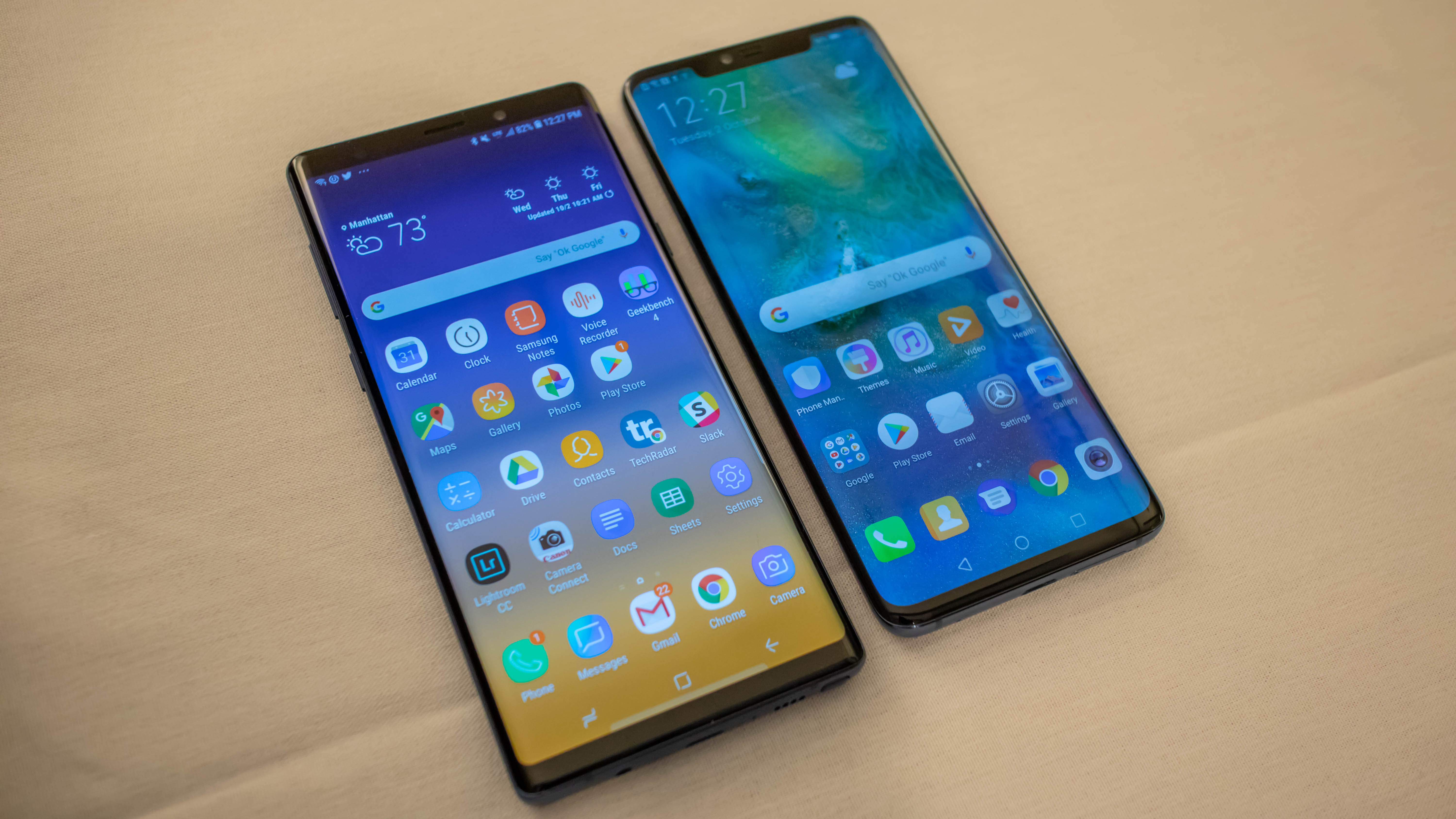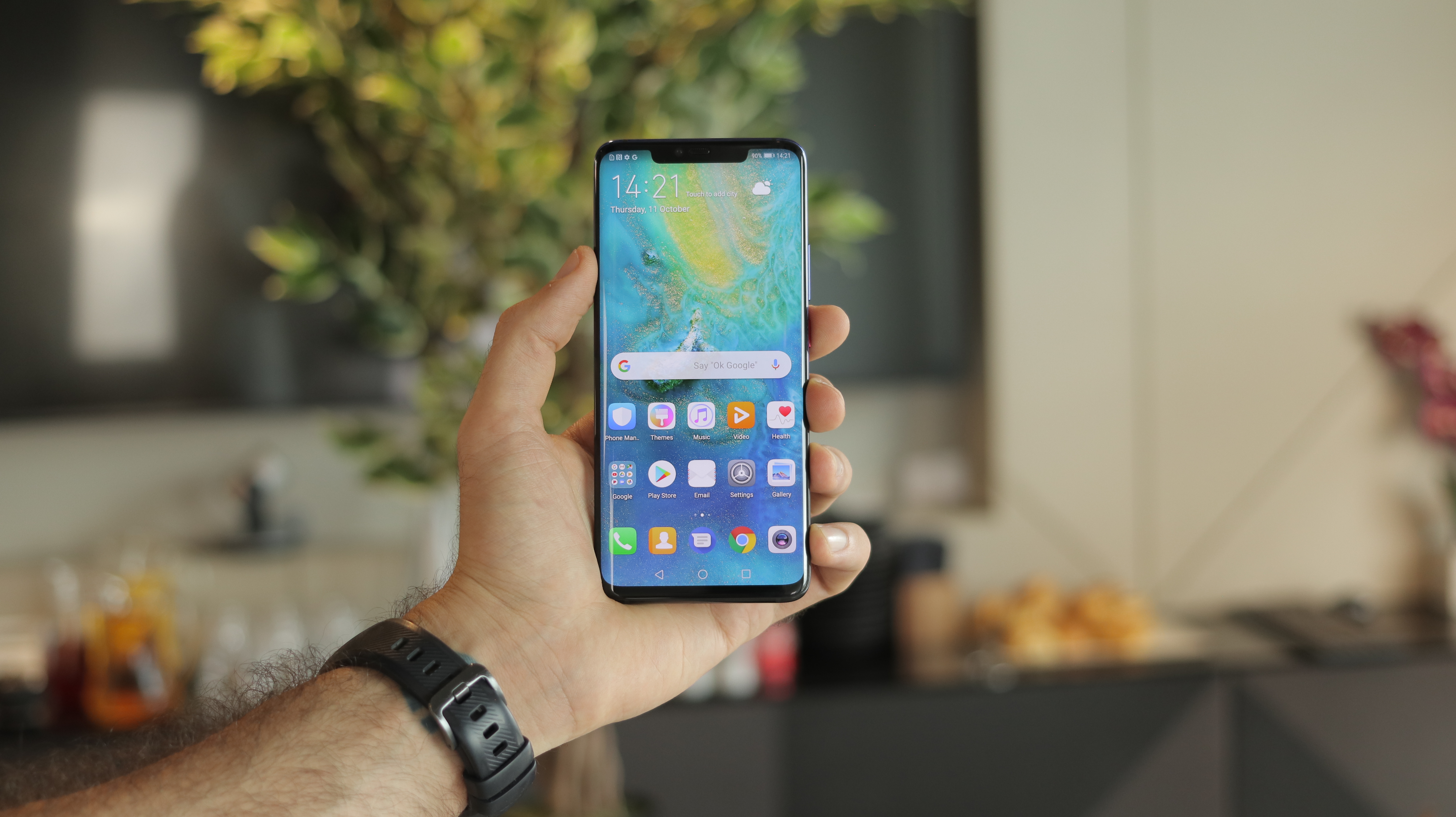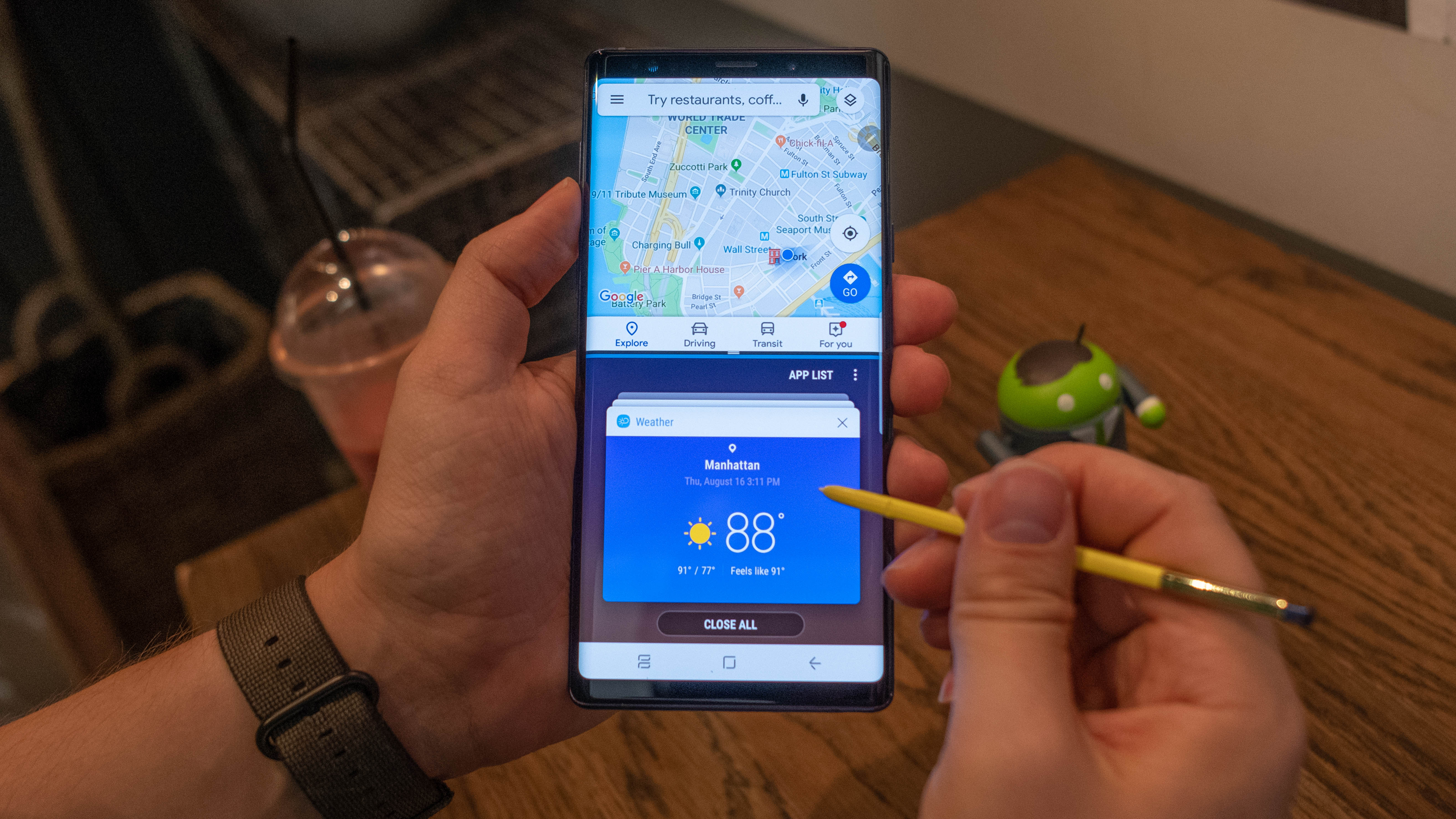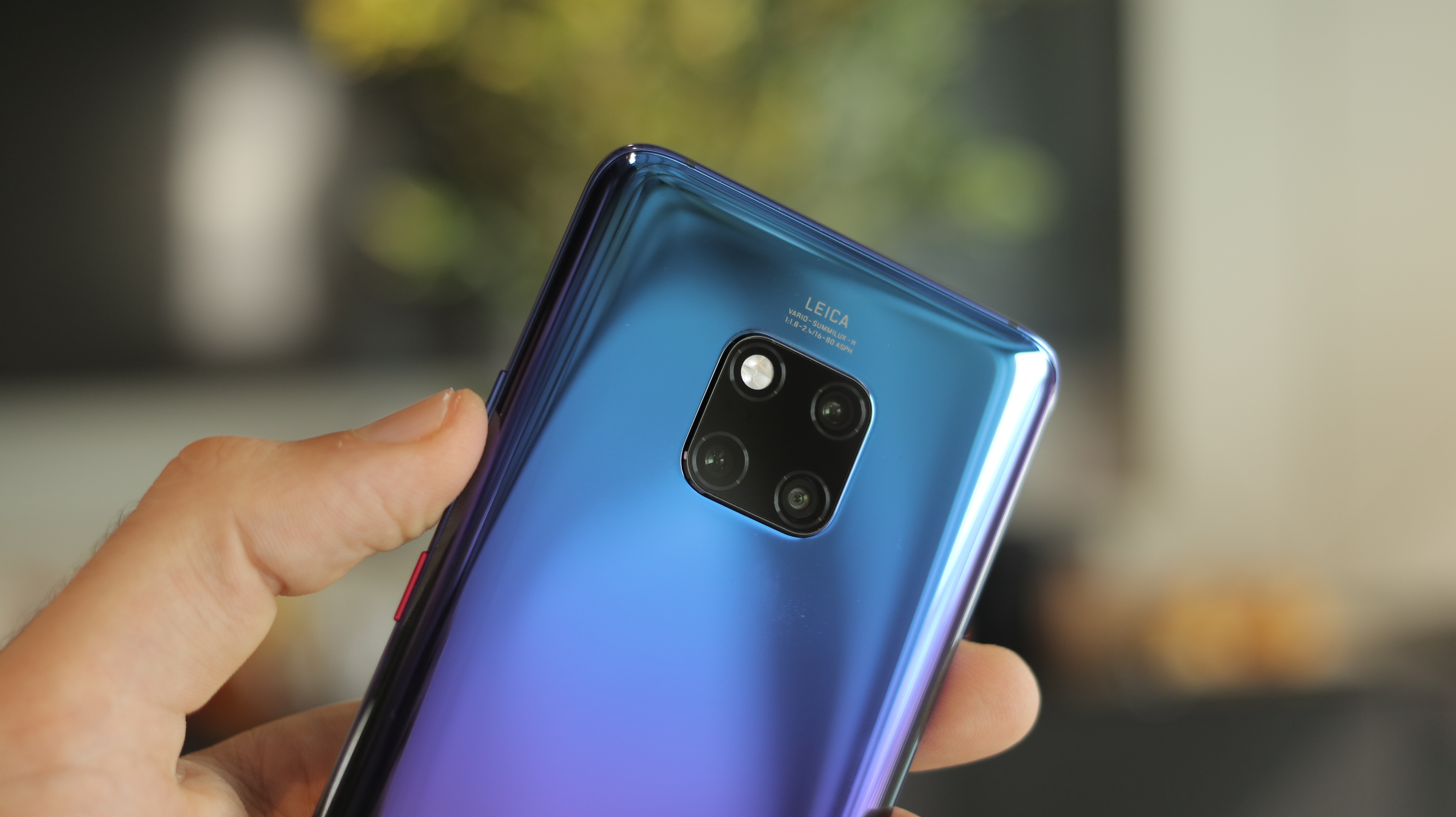Huawei Mate 20 Pro vs Samsung Galaxy Note 9
Both big, both curved, but quite different

The Huawei Mate 20 Pro is the latest Huawei phablet, and as a big-screen Android flagship its main competition arguably comes from the Samsung Galaxy Note 9.
Both phones are new, big, powerful, jam-packed full of features and have some other major similarities, such as curved screens. But they also have lots of differences, including their chipsets and cameras.
So to help you get to grips with the similarities and differences between these two handsets we’ve compared them across a range of key areas.
Update: We've now got the Huawei Mate 20 Pro price from the launch: €1049 (around $1215 / £920) for the 6GB and 128GB variant. Compare that to the Note 9, which costs $1,000 (£899 / AU$1,499 for the same spec.
Huawei Mate 20 Pro vs Samsung Galaxy Note 9 design
The Huawei Mate 20 Pro has a curved screen with a notch cut out at the top and a slim bezel below. The thin frame of this phone is metal, while the back is all glass.
The Samsung Galaxy Note 9 also has a curved screen, a metal frame and a glass back, but it doesn’t have a notch, instead relying on thin bezels both above and below its screen. The corners are also slightly less curved on the Galaxy Note 9, giving it a more rectangular shape than the Huawei Mate 20 Pro.
The back looks quite different too, despite both phones being clad in glass. The Samsung Galaxy Note 9 has a horizontally arranged set of camera lenses and flash, while the Mate 20 Pro arranges them in a square. The Galaxy Note 9 also has a fingerprint scanner below the camera, while the Mate 20 Pro’s scanner is built into the screen.
Sign up for breaking news, reviews, opinion, top tech deals, and more.

The two phones have different dimensions and weights as well. The Huawei Mate 20 Pro is 157.8 x 72.3 x 8.6mm and 189g, while the Samsung Galaxy Note 9 is 161.9 x 76.4 x 8.8mm and 201g. So the Note 9 is slightly bigger in every dimension, as well as being a bit heavier.
And of course it comes in different colors. Specifically, you can get the Note 9 in Metallic Copper, Lavender Purple, Ocean Blue and Midnight Black, while the Huawei Mate 20 Pro comes in Emerald Green, Midnight Blue, Twilight, Pink Gold and Black shades.
The Twilight color is worth highlighting as this shifts between different shades, much like the Twilight version of the Huawei P20 Pro does.
Huawei Mate 20 Pro vs Samsung Galaxy Note 9 display
The Huawei Mate 20 Pro has a 6.39-inch curved OLED screen with a resolution of 1440 x 3120, an aspect ratio of 19.5:9 and support for HDR.
The Samsung Galaxy Note 9 on the other hand has a 6.4-inch curved Super AMOLED screen with a resolution of 1440 x 2960, an aspect ratio of 18.5:9 and support for HDR.

So the screen tech is similar, but the Mate 20 Pro has a slightly smaller and slightly higher resolution display. It also has a marginally different aspect ratio, but on paper at least these two phones sound to have quite similar screens. That’s no bad thing, as in our Note 9 review we praised its screen, calling it “bright and punchy”.
How the Huawei Mate 20 Pro’s screen will compare in practice remains to be seen – stay tuned for our full review to get a better idea.
Huawei Mate 20 Pro vs Samsung Galaxy Note 9 OS and power
The Huawei Mate 20 Pro has an octa-core Kirin 980 chipset, clocked at up to 2.6Ghz. It also has a Mali-G76 GPU and dual neural processing units (NPUs).
The Samsung Galaxy Note 9 on the other hand has either an octa-core Snapdragon 845 chipset clocked at up to 2.8GHz and paired with an Adreno 630 GPU (if you’re in the US), or an octa-core Exynos 9810 chipset clocked at up to 2.7GHz and coupled with a Mali-G72 GPU (in most other regions).
These are all top-end chipsets, but as a newer chipset made on a 7nm process the Huawei Mate 20 Pro’s is likely to be more powerful and efficient than the 10nm chipsets used in the Galaxy Note 9.

RAM also potentially differs but in this case it’s in the Note 9’s favor, as while the Mate 20 Pro has 6GB of RAM, the Samsung Galaxy Note 9 comes with either 6GB or 8GB.
We’ll let you know exactly how the Mate 20 Pro performs once we’ve put it through a full review, but the Note 9 is no slouch.
As for the operating system, the Huawei Mate 20 Pro runs Android 9 Pie overlaid with the company’s EMUI interface, while the Samsung Galaxy Note 9 uses Android 8.1 with Samsung’s interface on top. You can expect the Note 9 to get upgraded to Android 9 at some point, though.

It’s worth noting here also that the Galaxy Note 9 comes with an S Pen stylus, which is one thing that sets it apart from the Huawei Mate 20 Pro.
The Samsung Galaxy Note 9 also potentially has more storage, with up to 512GB built-in compared to 128GB in the Mate 20 Pro. Though, both phones have expansion potential (via microSD in the case of the Note 9 and nano memory card for the Mate 20 Pro).
Huawei Mate 20 Pro vs Samsung Galaxy Note 9 camera and battery
You get a triple-lens camera on the Huawei Mate 20 Pro. It has a combination of a 20MP f/2.2 ultra-wide-angle lens, a 40MP f/1.8 wide-angle lens and an 8MP f/2.4 telephoto lens, the last of which has optical image stabilization (OIS) and support for 3x optical zoom.
The Samsung Galaxy Note 9 meanwhile has a dual-lens camera, with both a 12MP f/2.4 telephoto lens (with OIS and 2x optical zoom), and a 12MP lens that can vary its aperture between f/1.5 and f/2.4. That lens also has OIS.
Looking purely at the specs it’s hard to say which of these configurations would be better. We know from our review that the Note 9 has a very strong camera, but so too do recent Huawei flagships.

On the front, the Huawei Mate 20 Pro has a 24MP f/2.0 camera, while the Samsung Galaxy Note 9 has an 8MP f/1.7 one, so the Note 9’s has a lower megapixel count but a larger aperture.
As for the battery, the Huawei Mate 20 Pro has a 4,200mAh one, while the Samsung Galaxy Note 9 has a 4,000mAh one, so not a huge difference there but one which could work in the Mate 20 Pro’s favor.
The Galaxy Note 9 comfortably lasts more than a day in our tests, but we’ll let you know how long the Mate 20 Pro lasts in our review.
Takeaway
The Huawei Mate 20 Pro and the Samsung Galaxy Note 9 have a lot in common, from similarly large, curved OLED screens to top-end power, glass backs and similarly sized batteries.
However, the Mate 20 Pro has a newer chipset, a slightly sharper screen, an extra camera lens and a marginally larger battery, as well as a newer version of Android – at least for now. The Note 9 on the other hand could stand out through its S Pen stylus and its potentially higher storage capacity.
Of course, you’ll have to wait for our full Huawei Mate 20 Pro review to see how it stands up in practice, but based on the specs it should be a strong competitor to the Galaxy Note 9 – a phone that we already know is great.
James is a freelance phones, tablets and wearables writer and sub-editor at TechRadar. He has a love for everything ‘smart’, from watches to lights, and can often be found arguing with AI assistants or drowning in the latest apps. James also contributes to 3G.co.uk, 4G.co.uk and 5G.co.uk and has written for T3, Digital Camera World, Clarity Media and others, with work on the web, in print and on TV.